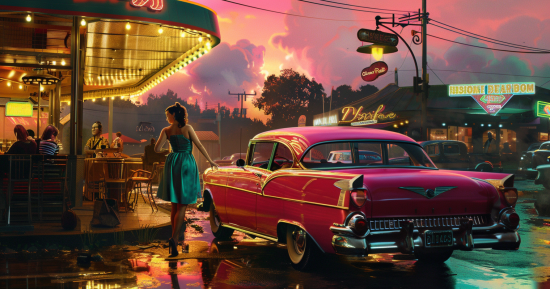The evolution of comic book art is **incredible**, going from simple sketches to the **vivid** and creative designs we see now. Knowing the **importance** of these different styles matters, no matter if you’re a long-time fan or just starting out. This piece explores the history and growth of comic book art, spotlighting the big trends shaping the industry today.
Comic Book Art
You’re likely familiar with classic styles like superheroes and manga, but did you know there are also realistic and surreal elements in comic book art? Mastering these distinctions can help you develop your artistic voice and weave intricate narratives. Dive into the history and evolution of comic book art styles to discover the iconic creators and groundbreaking works that shaped this vibrant medium.
Not only will you gain insight into how different art styles can express the story, characters, and themes of comics, but you’ll also explore the impact of digital art on the medium. Embrace the potential of comic book art and remember that the only limit is your imagination. Happy exploring!
History of Comic Book Art Style

Golden Age Comics
The Golden Age of comic books started around 1938 and lasted until the 1950s. During this period, comics had a unique stylistic distinction between good and evil, with superheroes portrayed as happy-go-lucky do-gooders. These comics were characterized by their simplistic drawings, minimal shading, and bold use of colors.
Here are some prominent features of Golden Age Comics:
- Basic art style
- Idealistic portrayal of superheroes
- Bright, bold colors
- Clear separation of good and evil
Silver Age Comics
The Silver Age of comic books began in the late 1950s and extended into the early 1970s. This era saw the revival and reinvention of many classic superheroes. Art styles during this period became more detailed and dynamic, making stories even more captivating. Silver Age Comics still used bold colors but incorporated more intricate techniques.
Key aspects of Silver Age Comics:
- Advanced art styles
- Revival of classic superheroes
- Use of science fiction themes
- Detailed and dynamic illustrations
Modern Comic Art Evolution
The Modern era of comic books started in the mid-1980s and continues today. During this period, comic book art evolved significantly with the introduction of digital art and experimental styles. Artists like Fiona Staples, J.H. Williams III, and David Aja have pushed the limits of visual storytelling, making comic art even more engaging.
Some distinguishing features of Modern Comic Art:
- Digital artwork
- Varied and unique art styles
- Emphasis on realism and darker themes
- Greater diversity in storytelling
As you can see, the comic book art style has grown immensely throughout history. From the simplistic drawings of the Golden Age to the innovative artistry of the Modern Era, comic books continue to captivate readers with their vibrant illustrations and storytelling.
Elements of Comic Book Art

Line Work and Inking
Regarding comic book art styles, the line work and inking are crucial in defining the overall look and feel. In the Golden Age of comic books, bold lines and dynamic artwork were the defining characteristics, with artists such as Joe Shuster and Bob Kane pioneering the visual language of superheroes. More contemporary styles have branched out into various inking techniques, including brushwork, stippling, and hatching, which have allowed artists to convey diverse emotions and atmospheres through their illustrations. Remember, experimenting with different inking styles can help you discover your unique artistic voice in the comic book world.
Coloring Techniques
The coloring techniques used in comic book art have evolved significantly. During the early days, artists relied on strong, primary colors to make their characters pop off the page. In more modern times, digital art tools have expanded the options available for coloring, providing artists with a broader range of colors and blending abilities. When exploring your personal comic book art style, consider experimenting with different coloring techniques, such as:
- Flat coloring
- Cel shading
- Airbrushing
- Painting
Mastering various coloring methods can further refine and develop your artistic vision.
Lettering and Typography
While the visuals are often the main focus of comic book art, lettering and typography should not be overlooked. Words and word containers help bring your comic to life by providing context and dialogue. The lettering style you choose can affect how your comic is perceived. Here are some tips for refining your lettering:
- Understand text hierarchy: Use different font sizes to differentiate between captions, dialogue, and sound effects.
- Legibility: Make sure your text is easy to read and doesn’t blend in with the background art.
- Placement: Position speech bubbles and caption boxes strategically to guide the reader’s eye through the comic.
- Fonts: Choose fonts that work well with your art style and convey the right atmosphere for your story.
By paying attention to these details, you can create a cohesive comic book art style that engages your readers and brings your stories to life in a visually compelling way.
Iconic Comic Book Art Styles
American Superhero Comics
In American superhero comics, you’ll often find a strong emphasis on dynamic gestures, muscular anatomy, and vibrant colors. This style can be seen in popular comic book titles such as Superman, Batman, and Spider-Man. Bold lines and dramatic shading techniques help to create an intense sense of action and energy. Some famous artists associated with this art style include Jim Steranko and Jack Kirby.
- Classic features of American superhero comics art style:
- Dynamic gestures
- Muscular anatomy
- Vibrant colors
- Bold lines and shading
Manga Style
Manga, a distinct comic book art style from Japan, is characterized by its unique visual elements that set it apart from other comic book styles. With various genres targeting different audiences, manga has something for everyone. Manga features exaggerated facial expressions, large eyes, and unique panel layouts. Among the well-known artists working in this style are Akira Toriyama, creator of Dragon Ball, and Naoko Takeuchi, creator of Sailor Moon.
- Distinctive elements of manga art style:
- Exaggerated facial expressions
- Large eyes on characters
- Unique panel layouts
European Bande Dessinée
The European comic book art style, known as Bande Dessinée, offers a different approach to storytelling, focusing on details and more realistic, painterly styles. Artists often use watercolors and inking techniques, and you’ll find that many European comics prioritize lush backgrounds and detailed character designs. Prominent examples of this style include Tintin by Hergé and Asterix by René Goscinny and Albert Uderzo.
- Key aspects of the European Bande Dessinée art style:
- Detailed, painterly illustrations
- Focus on lush backgrounds
- Use of watercolors and inking techniques
Enjoy exploring these iconic comic book art styles, as they each carry unique charm and visual language that attracts fans across the globe.
Creating Comic Art

Character Design
In comic book art, character design is essential to the creative process. Your characters must have unique and appealing visual traits to stand out and be memorable. Remember the importance of facial expressions, body language, and clothing to convey your character’s persona.
When designing your character, consider the following elements:
- Physical appearance – height, build, skin color, eye color, etc.
- Costume – outfit, color palette, accessories.
- Facial expressions – eyes, mouth, eyebrows, to convey emotions.
Focusing on these elements will help you to create memorable and visually appealing characters.
Storyboarding and Layouts
Next, you’ll dive into storyboarding and layouts, pivotal for shaping your comic’s narrative flow. You need to consider how the panels are arranged on the page, the transitions between them, and the pacing of your story.
Using the information from How to create comic book art | Adobe, you can learn to develop compositions in Adobe Illustrator and create compelling visual storytelling.
Be strategic about using angles, perspective, and zoom to guide your reader’s attention.
Remember the following aspects when developing your storyboard:
- Establish the sequence of events.
- Maintain a consistent style and tone.
- Use varying perspectives to keep things dynamic.
- Keep the flow of the story in mind.
Digital vs. Traditional Techniques

In comic book art, you can choose between digital and traditional techniques. Both methods offer unique advantages and challenges, so analyzing which suits you best is vital.
Here is a comparison of the two techniques:
| Digital Art | Traditional Art | |
|---|---|---|
| Speed | Faster work and easier editing | Slower process and more technique-dependent |
| Versatility | Multiple tools and brushes are available | Limited by available materials |
| Accessibility | Hardware and software investments | Accessible material-wise, but challenging to master techniques |
Ultimately, your choice will depend on your preferences and desired outcomes. Experiment with both methods and find the one that inspires your creativity.
Influence on Popular Culture

Merchandising and Media
Comic book art style has played an essential role in popular culture, becoming an influential force in various aspects of media and merchandising. Many iconic characters have emerged from comics, like Superman and Batman, and they’ve considerably impacted today’s society. With a bold and vibrant art style, comic books have spread beyond the printed pages and can often be found as inspiration for film, television, and video games.
In recent years, you’ve probably noticed the prevalence of superhero movies, where comic book art style often influences visual aspects such as costume design, color palettes, and framing. Similarly, the comic book style can often be found in high-profile animated series, marketing materials, and merchandise, like posters, toys, and clothing.
Moreover, comic book art style can influence the packaging design and concept of various consumer products, showcasing how ingrained this art form has become in popular culture.
Crossovers with Other Art Forms
Comic book art style has also made significant contributions to different art forms throughout the years. For example, graphic designers have taken inspiration from the vibrant colors and expressive typography of comics to create eye-catching designs across various fields like advertising and packaging design.
In addition, comic book art has even impacted more traditional art forms, such as painting and sculpture, with some artists incorporating elements of the comic style into their work to create unique pieces that blur the lines between high art and pop culture.
In conclusion, it’s evident how the comic book art style has impacted popular culture through media, merchandising, and other art forms. As a fan of comic book art, you can appreciate the rich history and the far-reaching influence this iconic style has had on our society and look forward to the many innovative ways it will continue to shape popular culture in the years to come.
FAQ – Comic Book Art
How do I find my comic art style?
Find your comic art style by studying various artists, experimenting with techniques, practicing consistently, and incorporating your tastes and experiences into your work. Let your unique style evolve naturally over time.
What does every comic book need?
Every comic book needs a strong narrative, engaging characters, dynamic artwork, panels for visual pacing, dialogue balloons, and a balance of action and exposition.
What makes a good comic?
A good comic has a compelling storyline, relatable characters, clear artwork, balanced pacing, and effective dialogue. Humor or drama should engage the reader emotionally and visually.
Dive into a vibrant collection of storytelling and illustration with our comic art book. Each page is a journey for the eyes and the mind, waiting to unfold. Make it yours, and let the adventure begin!






